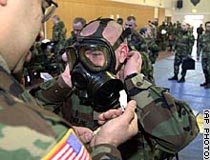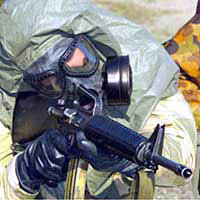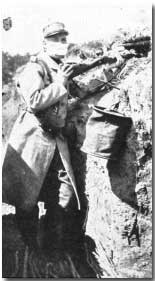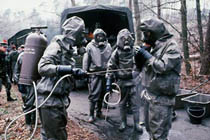|
|
The Invisible War
Though no chemical weapons have been used against allied troops as of April 6, 2003, evidence that Iraqi soldiers have been training for this type of warfare is mounting. Last week, for instance, military officials reported that interviews with Iraqi prisoners of war and intelligence from electronic eavesdropping on Iraqi government communications indicate that Saddam Hussein's forces have recently moved a stash of chemical weapons into the hands of a Republican Guard unit. Also, defensive measures -- such as gas masks, chemical weapons decontamination kits and detailed instructions on how to use protective suits -- were found at what appeared to be a training center. So far, no such weapons have yet been found, and Iraq denies having them or any other weapon of mass destruction. However, even before Operation Iraqi Freedom was launched, such offensive tactics by Iraqi militants seemed possible, and some say probable. In 2002, the Central Intelligence Agency reported that Iraq had not accounted for 15,000 artillery rockets. In the past, these rockets were the preferred means for delivering nerve agents. Iraq has also not accounted for about 550 artillery shells filled with mustard agent. Saddam Hussein used such agents in the 1980s, killing and wounding thousands of Iranians and Kurds.
For this week's lesson, you'll learn the difference between chemical and biological agents and how they work. You'll also explore the history of this type of warfare -- beginning as far back as Medieval times -- and find out how troops in Iraq are protecting themselves from such attacks. The Threats
What is the difference between "chemical" and "biological" types of agents? What are some examples of how each of them has been used? In what ways have international treaties addressed their use? Learn more about the most Feared Chemical Agents, Feared Biological Agents, and how they Spread. How are the agents different from each other in how they work to restrict or damage a person's body functions? How do their effects relate to how they can be delivered into people's systems?
Also, visit the Global Guide to Bioweapons section, to see how various nations are involved in this type of warfare. Next, investigate six of these agents up-close from the Agents of Bioterror index. What types of symptoms does each one cause? Which agents are contagious? Which ones are treatable? Now explore more of the science behind the scare, by meeting three professional Biowarriors -- Bill Patrick, Ken Alibek and Sergei Popov. You can choose to read the transcripts or watch the videos using a QuickTime or RealVideo player. What kind of experience does each scientist have with biological agents? What does each of them say about these methods of warfare -- from research to production and distribution? How did the bioweapons programs of the Soviet Union and United States differ, and how did they affect each other? The Defenses
Start reviewing the equipment list with one of the most basic pieces of protective equipment, the gas mask. Learn How Gas Masks Work, looking at the different Types of Gas Masks and investigating How Filters Work.
But, as you've learned, through the respiratory system isn't the only way these agents can injure or kill a person. Sometimes, agents can damage or enter through the skin. Your last stop for this week is at the Virtual Naval Hospital's Chemical Defense Equipment page. Although this site's technical descriptions might be tough to wade through, at least browse through the photos and read about each of the items, like the variety of field masks, bioweapons detection units, and the protective garments -- from gloves to boots -- that soldiers wear, for keeping their bodies safe. Also review the exhibit table labeled, Levels of Mission-Oriented Protective Posture. What features are different in the chemical protective clothing compared to regular pants and shirts? How do the protective postures vary depending on the threat situation? How would early detection of bioweapons attacks help soldiers prepare defensively? How challenging do you think it would be as a soldier to do your job while wearing this gear? Newspaper ActivitiesBrowse through issues of Targetnewspaper, looking for stories highlighting evidence of bioweapons production, distribution or use in Iraq. If a specific agent was found, was it chemical or biological? How was the it first detected? In what ways were coalition soldiers prepared for it? What kind of clean-up operation occurred or needs to occur for the area to be safe? If coalition forces found only gear or other bioweapons-related materials, are they related to offensive or defensive measures? If you find photos of soldiers in protective gear, what level of protection, and for what types of agents, does it show? ©
Copyright 2002 |
 As coalition forces advance into
the heart of Iraq, concerns about biological and chemical attacks keep
soldiers on their toes and gas masks within reach.
As coalition forces advance into
the heart of Iraq, concerns about biological and chemical attacks keep
soldiers on their toes and gas masks within reach. But Iraqis have not been the only ones
training for biological and chemical warfare. Coalition forces have been
preparing their own soldiers, while related defensive research and
development has been a U.S. priority for decades.
But Iraqis have not been the only ones
training for biological and chemical warfare. Coalition forces have been
preparing their own soldiers, while related defensive research and
development has been a U.S. priority for decades. Begin
your journey with an overview on
Begin
your journey with an overview on  Now
take a more in-depth view of biological agents at NOVA's
Now
take a more in-depth view of biological agents at NOVA's  Whether
soldiers face chemical or biological agents, the best way to avoid injury, or
death, is to keep them away from your body. Therefore, the U.S. military has
spent lots of time and money developing effective ways to protect our
personnel under such threatening conditions.
Whether
soldiers face chemical or biological agents, the best way to avoid injury, or
death, is to keep them away from your body. Therefore, the U.S. military has
spent lots of time and money developing effective ways to protect our
personnel under such threatening conditions. What
are the advantages and disadvantages of each kind of respirator if a soldier
comes under chemical attack? How about in a biological attack? How exactly
does the filter work to prohibit chemicals or biologicals from entering the
body?
What
are the advantages and disadvantages of each kind of respirator if a soldier
comes under chemical attack? How about in a biological attack? How exactly
does the filter work to prohibit chemicals or biologicals from entering the
body?